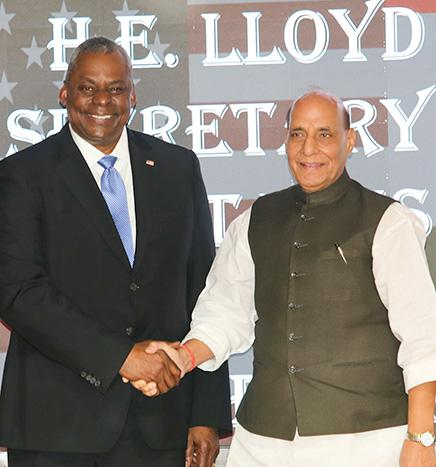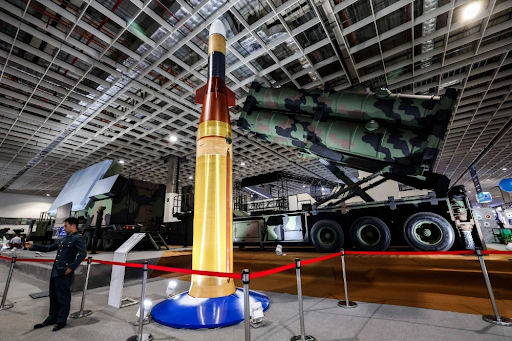Description

Disclaimer: Copyright infringement not intended.
Context
- Bilateral meeting between Defence Minister Rajnath Singh of India and visiting U.S. Secretary of Defence Lloyd Austin.
Details
Bilateral Meeting and Roadmap for Defence Industrial Cooperation:
- India and the US concluded a roadmap for 'Defence Industrial Cooperation.'
- The roadmap aims to guide policy direction for cooperation in high technology areas and identify opportunities for co-development and co-production.
- Discussions focused on building resilient supply chains and strengthening industrial cooperation.
- Emphasis on collaboration between defense start-up ecosystems of both countries.
Key Discussions and Areas of Cooperation:
- Exploration of ways to enhance defense cooperation in various areas.
- Convergence of strategic interests and enhanced security cooperation.
- Commitment to a free and open Indo-Pacific region.
- Review of bilateral defence cooperation activities and maintenance of engagement momentum.
- Inaugural dialogues on defence Artificial Intelligence and defence space.
- Discussion on regional security issues and maintaining peace and stability in the Indo-Pacific region.
India's Requests and Concerns:
- Request to remove stringent hurdles and complicated rules and regulations in the sales of military equipment and transfer of critical defence technologies.
- Concerns about Pakistan's trustworthiness in handling western military equipment and platforms.
Collaboration on Critical and Advanced Technologies:
- Focus on collaboration in critical and advanced technologies, particularly in the underwater domain.
- Possibility of collaborating on indigenous jet engine manufacturing between Hindustan Aeronautics Limited (HAL) and General Electric (GE).
- Request for easing US rules and regulations on defense equipment sales and technology transfers.
- Importance of sourcing parts from India in relevant defence deals.
- Emphasis on setting up Maintenance, Repair, and Overhaul (MRO) facilities in India.
Strengthening Operational Collaboration and Technology Cooperation:
- Commitment to strengthen operational collaboration across all military services.
- Support for India's leading role as a security provider in the Indo-Pacific.
- New Roadmap for US-India Defense Industrial Cooperation to fast-track technology cooperation and co-production.
- Focus areas include air combat and land mobility systems, intelligence, surveillance, and reconnaissance, munitions, and the undersea domain.
- Reviewing regulatory hurdles and initiating negotiations on Security of Supply Arrangement and Reciprocal Defense Procurement agreement.
- Growing importance of defence innovation and cooperation in emerging domains such as space, cyberspace, and artificial intelligence.
India-US Defense Acceleration Ecosystem (INDUS-X):
- Establishment of INDUS-X as a new initiative to advance cutting-edge technology cooperation.
- Promotes innovative partnerships between US and Indian companies, investors, start-up accelerators, and academic research institutions.
- Launching by the US-India Business Council on June 21, 2023.
Meeting with National Security Advisor:
- Exchange of views on regional and global security issues, including maritime security in the Indian Ocean Region.
- Roadmap for US-India Defence Industrial Cooperation will guide policy direction for the next few years.
- Participation of senior officials from the Ministry of Defence, Chief of Defence Staff, Defence Secretary, and Chairman of Defence Research and Development Organisation (DRDO).
Background of India US Defence Relations
- The India-US defense relationship has its roots in the early 1990s, when the two countries began to cooperate on a limited basis in areas such as counter-terrorism and defense technology.
- In 2004, the US and India signed a landmark agreement that removed restrictions on the sale of US defense technology to India.
- This agreement paved the way for a significant increase in defense cooperation between the two countries, which has continued to grow in recent years.

Key Areas of Cooperation:
- The two countries cooperate in a wide range of defense areas, including:
- Counter-terrorism
- Humanitarian assistance and disaster relief
- Maritime security
- Space
- Missile defense
- Nuclear security
- Military training and exercises
- The two countries also work together on a number of defense-related research and development projects.
Challenges:
- Despite the progress that has been made, there are still some challenges to the India-US defense relationship.
- One challenge is the different security priorities of the two countries.
- The US is primarily concerned with security threats in the Middle East and Asia, while India is more focused on security threats in its immediate neighborhood.
- Another challenge is the Indian government's reluctance to open up its defense industry to foreign investment.
- The Indian government is concerned about losing control of its defense industry and about the potential for foreign companies to steal sensitive technology.
Major Developments in India US Defense Relations:
- 2005: The US and India signed the New Framework for the US-India Defense Relationship, which established a roadmap for cooperation in areas such as defense technology, joint exercises, and training.
- 2008: The US and India signed the Logistics Exchange Memorandum of Agreement (LEMOA), which allows the two countries to share logistical support during joint military operations.
- 2016: The US and India signed the Communications Compatibility and Security Agreement (COMCASA), which allows the two countries to share sensitive communications information.
- 2020: The US and India signed the Basic Exchange and Cooperation Agreement (BECA), which allows the two countries to share geospatial information.
- 2022: The US and India signed a $3 billion deal for India to purchase 24 MH-60R Seahawk helicopters from the US.
- 2023: The US and India conducted their largest-ever joint military exercise, Malabar. The exercise included over 20 ships, 20 aircraft, and 2,500 personnel from the two countries.
|
PRACTICE QUESTION
Q. Discuss the growing nature of Indo-US relationship in defense sector in the changing geopolitical scenario. (250 words)
|
https://epaper.thehindu.com/ccidist-ws/th/th_delhi/issues/38621/OPS/G05BAOEM6.1+GV2BAP8CN.1.html
https://indianexpress.com/article/india/remove-hurdles-in-defence-sales-tech-transfer-india-to-us-8647387/













